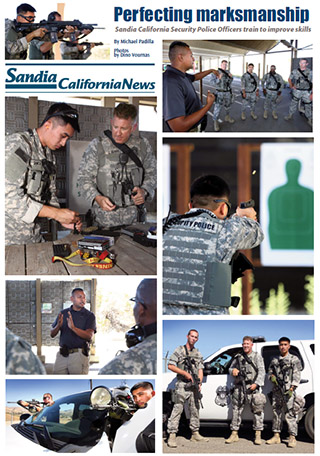Sandia/California Security Police Officers train to improve skills

Sandia’s Security Police Officers in training at Sandia/California
Training trumps everything.
Security Police Officers (SPO) at Sandia/California continue to far exceed the minimum standard of required training.
Pablo Maurino (8511), the lead training instructor for the site, says the Protective Force conducts training throughout the year and officers participate in live fire training eight to 10 times a year. Firearms training is typically an eight-hour day; however, SPOs may also receive live fire training on the range in shorter durations while on shift as scheduling permits. Each SPO has to qualify semi-annually with a duty-issued Glock 9mm and the H&K 416 rifle.
“We all understand that 99 percent of an SPO’s career will consist of protecting a facility, its people, and classified documents, constantly deterring but never seeing the enemy,” says Pablo. “We train for the 1 percent, the one time we have to get it right.”
He says the most important part of training is the support required to train. There is no lack of talent or desire within the Protective Force. “Our success is ultimately determined by the support we receive from managers, oversight, safety, and the laboratory workforce,” he says.
Having a live fire range on site is a tremendous resource for the SPOs, Pablo says. The range is also used for weapons manipulation, which is a key component to being an efficient operator. Many hours are spent on these fundamentals using dummy ammunition or dry practice — no ammo used.
Sandia follows DOE’s readiness training program adopted from the military known as EMETL (Enterprise Mission Essential Task List). This program takes everything an SPO is required to do within his or her job scope and identifies it as task. These tasks are then categorized as collective, leader, or individual. There are 15 collective, 27 leader, and 36 individual tasks. The EMETL system is used to develop leaders and SPOs. The training department is tasked with identifying which skills SPOs need to improve to become more efficient. Training is then developed around what has been identified. On duty, SPOs receive additional training from their supervisors using the EMETL field manual as a guideline.
Keeping training fresh
Dennis Baker (8511), manager of Sandia/California’s Security and Emergency Management, says there are many challenges facing the Protective Force.
“Understanding that the world around us is changing rapidly is our greatest challenge,” Dennis says. “The need to adapt and remain relevant through training is critical.”
Since the world is continuously changing, Sandia is careful not to approach new problems with old strategies. The workplace violence/active shooter is an example of an evolving threat. In training, the Protective Force has looked carefully at this threat to identify trends, courses of action, and response techniques. It has been made a top priority and the Protective Force trains every day to prevent this threat and respond accordingly should the situation ever arise.
A recent training venture for Sandia Pro Force is the integration of leadership training with Lawrence Livermore National Laboratory’s Protective Force. This training consisted of tabletop exercises and a force-on-force scenario.
Pablo was recently selected by NNSA to attend an Adaptive Leadership course taught by former members of the Army’s elite Delta Force. Pablo incorporated many of the concepts and strategies with training at Sandia/California. As a subject matter expert for active shooter training for DOE’s National Training Center in Albuquerque, Pablo has begun training the Protective Force on rapid response.